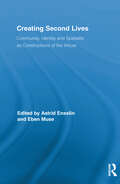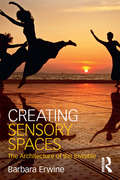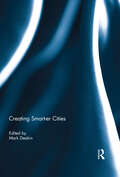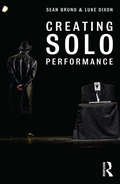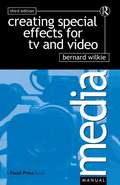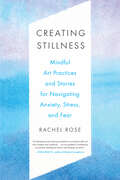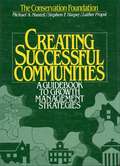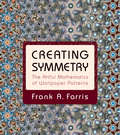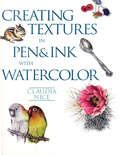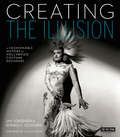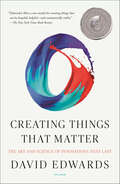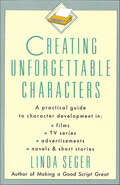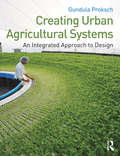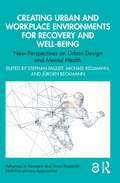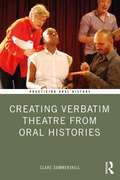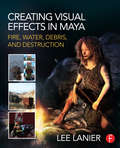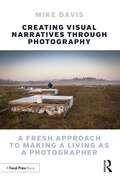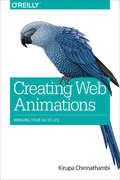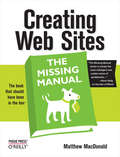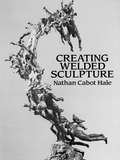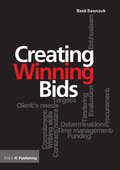- Table View
- List View
Creating Second Lives: Community, Identity and Spatiality as Constructions of the Virtual (Routledge Studies in New Media and Cyberculture)
by Astrid Ensslin Eben MuseThis book aims to provide insights into how ‘second lives’ in the sense of virtual identities and communities are constructed textually, semiotically and discursively, specifically in the online environment Second Life and Massively Multiplayer Online Games such as World of Warcraft. The book’s philosophy is multi-disciplinary and its goal is to explore the question of how we as gamers and residents of virtual worlds construct alternative online realities in a variety of ways. Of particular significance to this endeavour are conceptions of the body in cyberspace and of spatiality, which manifests itself in ‘natural’ and built environments as well as the triad of space, place and landscape. The contributors’ disciplinary backgrounds include media, communication, cultural and literary studies, and they examine issues of reception and production, identity, community, gender, spatiality, natural and built environments using a plethora of methodological approaches ranging from theoretical and philosophical contemplation through social semiotics to corpus-based discourse analysis.
Creating Sensory Spaces: The Architecture of the Invisible
by Barbara ErwineCreating Sensory Spaces celebrates spaces enlivened with sensual richness and provides you with the knowledge and tools necessary to create them. Drawing on numerous built case studies in ten countries and illustrated with over 85 full color images, the book presents a new framework for the design of sensory spaces including light, color, temperature, smell, sound, and touch. Bridging across disciplines of architecture, engineering, phenomenology and perceptual psychology, this book informs the design of buildings and neighborhoods that reclaim the role of the body and all the senses in creating memorable experiences of place and belonging.
Creating Smart-er Cities
by Mark DeakinDrawing upon the smart experiences of "world class" cities in North America, Canada and Europe, this book provides the evidence to show how entrepreneurship-based and market-dependent representations of knowledge production are now being replaced with a community of policy makers, academic leaders, corporate strategists and growth management alliances, with the potential to liberate cities from the stagnation which they have previously been locked into by offering communities: the freedom to develop polices, with the leadership and strategies capable of reaching beyond the idea of "creative slack"; a process of reinvention, whereby cities become "smarter," in using intellectual capital to not only meet the efficiency requirements of wealth creation, but to become centres of creative slack; the political leadership capable of not only being economically innovative, or culturally creative, but enterprising in opening-up, reflexively absorbing and discursively shaping the democratic governance of such developments; the democratic governance to sustain such developments. Drawing together the critical insights from papers from a collection of leading international experts on the transition to smart cities, this book proposes to do what has recently been asked of those responsible for creating Smarter Cities. That is: provide the definitional components, critical insights and institutional means by which to get beyond the all too often self-congratulatory tone cities across the world strike when claiming to be smart and by focussing on the critical role master-plans and design codes play in supporting the sustainable development of communities.This book was published as a special issue of Urban Technology.
Creating Solo Performance
by Luke Dixon Sean BrunoCreating Solo Performance is an innovative toolbox of exercises and challenges focused on providing you – the performer – with engaging and inspiring ways to explore and develop your idea both on the page and in the performance space. The creation of a solo show may be the most rewarding, liberating and stressful challenge you will take on in your career. This book acts as your silent collaborator as you develop your performance, by helpfully arranging exercises under the following headings: Beginnings Creating character Generating material Using your performance space Technology Endings Collaboration Exercises can be explored in sequence, at random or according to your specific needs and interests as a performer. By enabling you to create a bespoke formula that best applies to your specific subject, area of interest, style and discipline, this book will become an indispensable resource as you produce your solo show.
Creating Special Effects for TV and Video (Media Manuals Ser.)
by Bernard WilkieCreating Special Effects for TV and Video is a concise and practical introduction to the techniques used in television production. Now completely updated, this third edition covers a wide range of special effects in a simple and practical form, with clear illustrations and photographs that support the text. Creating Special Effects for TV and Video is a concise and practical introduction to the techniques used in television production. Now completely updated, this third edition covers a wide range of special effects in a simple and practical form, with clear illustrations and photographs that support the text.Bernard Wilkie now a freelance consultant, director and writer, spent 25 years creating special effects for BBC TV where he became manager of one of the largest and most specialised visual FX units in the world.
Creating Stillness: Mindful Art Practices and Stories for Navigating Anxiety, Stress, and Fear
by Rachel RoseDiscover the healing power of expressive arts with this hands-on guide to using creative mindfulness to reduce stress, find presence, and unlock self-knowledge Expressive arts educator Rachel Rose weaves together mindfulness practice and art therapy to demonstrate how tapping into your own innate creativity can help you find peace in a stressful worldThis self-directed guide teaches ten key principles of mindfulness through ten creative invitations, along with a series of simple exercises and guided prompts to help you start noticing and flexing your creative mindfulness muscles: Anchoring your practice with ritual Setting intentions Honoring your impulses Trusting the process Non-striving Letting goRequiring no prior experience of the arts or mindfulness meditation, Creating Stillness provides tools to explore difficult emotions and find insight into personal struggles and traumatic wounds.In each chapter, Rose draws from her personal experience as a teacher and facilitator of creative mindfulness to share stories and examples that help ground exercises like sketching, creative writing prompts, and more.Rose carefully walks through the process each time, explaining how to set intention and arrive in the present moment before embarking on your mindful art session; how to use objects and thoughts as creative prompts; how to return your attention to your work as you move forward; and how to distill the wisdom you have found in the process. For seasoned artists, creative mindfulness offers a chance to slow down and rediscover the transformative power that art can offer when it is detached from the need to produce something beautiful or useful. For those coming to expressive arts with existing mindfulness practices or engaged in a therapeutic process, a mindful arts practice may reveal a passion for creation you didn&’t know existed. And for everyone, creative mindfulness can help us make sense of our feelings and find new ways of expressing ourselves--in art and in life.
Creating Successful Communities: A Guidebook To Growth Management Strategies
by Luther Propst Michael The Conservation Foundation Stephen F. Harper Michael MantellCreating Successful Communities is a practical compendium of techniques for effective land use and growth management. It offers a framework for land-use decisionmaking and growth management: techniques for protecting key resources such as agricultural land, open space, historic and cultural structure, aesthetics, and rivers and wetlands as well as ways to organize effectively. The companion Resource Guide provides detailed information on topics covered in I>Creating Successful Communities.
Creating Symmetry
by Frank A. FarrisThis lavishly illustrated book provides a hands-on, step-by-step introduction to the intriguing mathematics of symmetry. Instead of breaking up patterns into blocks--a sort of potato-stamp method--Frank Farris offers a completely new waveform approach that enables you to create an endless variety of rosettes, friezes, and wallpaper patterns: dazzling art images where the beauty of nature meets the precision of mathematics.Featuring more than 100 stunning color illustrations and requiring only a modest background in math, Creating Symmetry begins by addressing the enigma of a simple curve, whose curious symmetry seems unexplained by its formula. Farris describes how complex numbers unlock the mystery, and how they lead to the next steps on an engaging path to constructing waveforms. He explains how to devise waveforms for each of the 17 possible wallpaper types, and then guides you through a host of other fascinating topics in symmetry, such as color-reversing patterns, three-color patterns, polyhedral symmetry, and hyperbolic symmetry. Along the way, Farris demonstrates how to marry waveforms with photographic images to construct beautiful symmetry patterns as he gradually familiarizes you with more advanced mathematics, including group theory, functional analysis, and partial differential equations. As you progress through the book, you'll learn how to create breathtaking art images of your own.Fun, accessible, and challenging, Creating Symmetry features numerous examples and exercises throughout, as well as engaging discussions of the history behind the mathematics presented in the book.
Creating Textured Landscapes with Pen, Ink and Watercolor
by Claudia NiceCapture the Rich Textures of Nature, Step by StepCapture nature's beauty as you never have before. Beloved artist and teacher Claudia Nice leads you on an inspired journey through the great outdoors. With paints in hand, she shares with you her best techniques for creating landscapes that come alive with richness, depth and textured detail. Open this guide and start painting right away. As you follow engaging, step-by-step demonstrations and exercises, you'll learn to recreate the textural elements of a range of terrains and landscapes. Chapters include:Creative clouds and skies Majestic mountains, hills and mesas Texturing trees, trunks and foliageRugged rocks and gritty gravel Transparent textures for rivers, falls and lakes Flowers of the field In a special section, Claudia covers basic texturing techniques with mini demos using lines, dots, bruising, scribbling, spattering, blotting, printing, stamping and more. From paints and pens to sponges, leaves and facial tissue, you'll explore all kinds of fun and inventive ways to create amazing textures. And to help you put it all together, Claudia includes her masterful advice for creating compositions using reference photos, field sketches and your own creative license. Each demonstration features a large image of the completed landscape, so you can see exactly how Claudia's methods work - from start to finish.
Creating Textures in Pen & Ink with Watercolor
by Claudia NiceClaudia Nice shows you how to turn ink and watercolors into the coarse-barked trunk of an oak, or the burnished smoothness of brass, or the verdant velvet of moss. Or any of many other things. She shows you how to use dots, fine lines, brushstrokes, black and white, color-a mixture of mediums and techniques-to suggest:glass cast iron adobe and brick sunrise and sunset driftwood leaf textures basketry surf and ocean waves enamelware rainbows wood grain distant trees eggs and onions animal hair and dozens of other textures! You'll learn how to use materials, from technical pens to paint brushes, colored inks to liquid acrylics. You'll discover ways to blot, spatter, stamp and otherwise alter and combine ink and watercolor for exciting texturing effects.
Creating Textures in Watercolor: A Guide to Painting 83 Textures from Grass to Glass to Tree Bark to Fur
by Cathy JohnsonSilken strands of hair. Water tumbling over rocks. Blinding reflections in glass or metal.Cathy Johnson shows you how to create realistic textures like these and make your watercolor paintings come alive.You'll find practical, easy-to-follow guidelines inside for creating 83 wonderful textures for fruits, vegetables, hair, glass, metal, fabric, flowers, fur, skin and much, much more.Johnson's beautiful watercolor sketches - complete with helpful captions - demonstrate each of these techniques and their many variations. You'll learn how to accurately recreate any texture you see and create lovely watercolor paintings that almost seem to breathe.Cathy Johnson's expertise will show you how to expand your own artistic vision and discover a world of textures - a world you can capture with your brush.
Creating The Illusion: A Fashionable History Of Hollywood Costume Designers (Turner Classic Movies)
by Jay Jorgensen Donald L. ScogginsMarilyn Monroe made history by standing over a subway grating in a white pleated halter dress designed by William Travilla. Hubert de Givenchy immortalized the Little Black Dress with a single opening scene in Breakfast at Tiffany’s. A red nylon jacket signaled to audiences that James Dean was a Rebel Without a Cause. For more than a century, costume designers have left indelible impressions on moviegoers’ minds. Yet until now, so little has been known about the designers themselves and their work to complement and enrich stories through fashion. Creating the Illusion presents the history of fashion on film, showcasing not only classic moments from film favorites, but a host of untold stories about the creative talent working behind the scenes to dress the stars from the silent era to the present day. Among the book’s sixty-five designer profiles are Clare West, Howard Greer, Adrian, Walter Plunkett, Travis Banton, Irene, Edith Head, Cecil Beaton, Bob Mackie, and Colleen Atwood. The designers’ stories are set against the backdrop of Hollywood: how they collaborated with great movie stars and filmmakers; how they maneuvered within the studio system; and how they came to design clothing that remains iconic decades after its first appearance. The array of films discussed and showcased through photos spans more than one hundred years, from draping Rudolph Valentino in exotic "sheik” dress to the legendary costuming of Gone with the Wind, Alfred Hitchcock thrillers, Bonnie and Clyde, Reservoir Dogs, and beyond. This gloriously illustrated volume includes candid photos of the designers at work, portraits and wardrobe tests of stars in costume, and designer sketches. Drawing from archival material and dozens of new interviews with award-winning designers, authors Jay Jorgensen and Donald L. Scoggins offer a highly informative, lavish, and entertaining history of Hollywood costume design.
Creating Things That Matter: The Art and Science of Innovations That Last
by David EdwardsMost things we create will not matter. This book is about creating things that do, from a master innovator who brings science and art together in his cutting edge labs.Art and science are famous opposites. Contemporary innovation mostly keeps them far apart. But in this book, David Edwards—world-renowned inventor; Harvard professor of the practice of idea translation; creator of breathable insulin, edible food packaging, and digital scents—reveals that the secret to creating very new things of lasting benefit, including innovations we will need to sustain human life on the planet, lies in perceiving art and science as one.Here Edwards shares how he discovered a way of creating that transcends disciplines and incorporates the principles of aesthetics. He introduces us to cutting-edge artists, musicians, architects, physicists, mathematicians, engineers, chefs, choreographers, and novelists (among others) and uncovers a three-step cycle they all share in creating things that durably matter. This creator cycle looks unlike what we associate with game-changing innovation today, and aligns the most expressive art and the most revolutionary science in a radical reimagining of how we live. David Edwards and the innovators he profiles belong to an emerging grassroots renaissance flourishing in special environments that we all can make in our schools, companies and homes.Creating Things That Matter is a book for anyone wondering what tomorrow might be, and at last half believing that what they do can make a difference.
Creating Unforgettable Characters: A Practical Guide to Character Development in Films, TV Series, Advertisements, Novels & Short Stories
by Linda SegerFrom a longtime script consultant, “a vital aid to all writers, novelists, and screenwriters . . . invaluable” (Gale Anne Hurd, producer, The Walking Dead and Aliens).In this book, Linda Seger, author of Making a Good Script Great, shows how to create strong, multidimensional characters in fiction, covering everything from research to character block. She introduces concepts designed to stimulate the creative process, combining them with practical techniques and exercises. She also offers specific advice on creating nonfiction and fantasy characters, and case studies of such classics as Ordinary People and the sitcom Cheers.Addressing topics from backstory development to character psychology to avoiding stereotypes, Creating Unforgettable Characters is an excellent resource for writers in any genre or creative field. Interviews with successful professional writers complete this essential volume.
Creating Urban Agricultural Systems: An Integrated Approach to Design
by Gundula ProkschCreating Urban Agriculture Systems provides you with background, expertise, and inspiration for designing with urban agriculture. It shows you how to grow food in buildings and cities, operate growing systems, and integrate them with natural cycles and existing infrastructures. It teaches you the essential environmental inputs and operational strategies of urban farms, and inspires community and design tools for innovative operations and sustainable urban environments that produce fresh, local food. Over 70 projects and 16 in-depth case studies of productive, integrated systems, located in North America, Europe, and Asia ,are organized by their emphasis on nutrient, water, and energy management, farm operation, community integration and design approaches so that you can see innovative strategies in action. Interviews with leading architecture firms, including WORKac, Kiss + Cathcart, Weber Thompson, CJ Lim/Studio 8, and SOA Architectes, highlight the challenges and rewards you face when creating urban agriculture systems. Catalogs of growing and building systems, a glossary, bibliography, and abstracts will help you find information fast.
Creating Urban and Workplace Environments for Recovery and Well-being: New Perspectives on Urban Design and Mental Health (Advances in Recovery and Stress Research)
by Stephan Pauleit Michael Kellmann Jürgen BeckmannThis essential book offers suggestions for how cities and spaces can be planned and designed to reduce the impact of stress, provide opportunities for recovery, and promote the resilience of individuals in urban communities.Connecting research from different scientific disciplines, the book provides a broader perspective of creating healthy lifestyle in society. It focuses on mental health and well-being by exploring how urban and workplace environments can be created to enhance and promote recovery. Divided into three parts, the book begins by investigating the multi-dimensional challenges of planning and design for stress reduction and recovery in urban areas. Part 2 concentrates on the design of residential and working environments, including commuting between the two, while Part 3 considers how neighbourhoods and entire cities contribute to or obstruct stress reduction, recovery, and well-being. The book concludes by demonstrating how the insights from the book can be implemented in practice to create restorative and inclusive environments. Bringing together leading experts, the book offers an interdisciplinary perspective for increasing well-being in urban developments.The book will be of interest to researchers and practitioners in related fields, including environmental psychologists, urban planners, architects and landscape architects, healthcare staff, and policymakers.
Creating Verbatim Theatre from Oral Histories (Practicing Oral History)
by Clare SummerskillOffering a roadmap for practicing verbatim theatre (plays created from oral histories), this book outlines theatre processes through the lens of oral history and draws upon oral history scholarship to bring best practices from that discipline to theatre practitioners. This book opens with an overview of oral history and verbatim theatre, considering the ways in which existing oral history debates can inform verbatim theatre processes and highlights necessary ethical considerations within each field, which are especially prevalent when working with narrators from marginalised communities. It provides a step-by-step guide to creating plays from interviews and contains practical guidance for determining the scope of a theatre project: identifying narrators and conducting interviews, developing a script from excerpts of interview transcripts and outlining a variety of ways to create verbatim theatre productions. By bringing together this explicit discussion of oral history in relationship to theatre based on personal testimonies, the reader gains insight into each field and the close relationship between the two. Supported by international case studies that cover a wide range of working methods and productions, including The Laramie Project and Parramatta Girls, this is the perfect guide for oral historians producing dramatic representations of the material they have sourced through interviews, and for writers creating professional theatre productions, community projects or student plays.
Creating Vibrant Public Spaces: Streetscape Design in Commercial and Historic Districts
by Ned CrankshawPublic space and street design in commercial districts can dictate the success or failure of walkable community centers. Instead of focusing our efforts on designing new "compact town centers," many of which are located in the suburbs, we should instead be revitalizing existing authentic town centers. This informative, practical book describes methods for restoring the health and vibrancy of the streets and public spaces of our existing commercial districts in ways that will make them positive alternatives to suburban sprawl while respecting their historic character. Clearly written and with numerous photos to enhance the text, Creating Vibrant Public Spaces uses examples from communities across the United States to illustrate the potential for restoring the balance provided by older urban centers between automobile access and "walkability." In advice that can be applied to a variety of settings and scales, Crankshaw describes the tenets of contemporary design theory, how to understand the physical evolution of towns, how to analyze existing conditions, and how to evaluate the feasibility of design recommendations. Good design in commercial centers, Crankshaw contends, facilitates movement and access, creates dynamic social spaces, and contributes to the sense of a "center"--a place where social, commercial, and institutional interaction is more vibrant than in surrounding districts. For all the talk of creating new "green" urban spaces, the ingredients of environmentally aware design, he points out, can often be found in the deteriorating cores and neighborhoods of towns and cities across the United States. With creativity, planning, and commitment, these centers can thrive again, adding to the quality of local life and contributing to the local economy, too.
Creating Visual Effects in Maya: Fire, Water, Debris, and Destruction
by Lee LanierProduce mind-blowing visual effects with Autodesk Maya. Gain the practical skills and knowledge you need to recreate phenomena critical to visual effects work, including fire, water, smoke, explosions, and destruction, as well as their integration with real-world film and video. In Creating Visual Effects in Maya, Maya master Lee Lanier has combined the latest studio techniques with multi-chapter, hands-on projects and professionally-vetted workflows to bolster your CG toolkit. Engaging, full-color tutorials cover: Creating foliage, fire, and smoke with Paint Effects Growing Maya Fur and nHair on clothing, characters, and sets Replicating water, smoke, sparks, swarms, bubbles, and debris with nParticles and nCloth Controlling scenes and simulations with expressions and MEL, Python, and PyMEL scripting Adding dust, fog, smoke, rippling water, and fireballs with Fluid Effects containers Creating damage with Effects presets, deformers, and animated textures Matchmoving and motion tracking with Maya and MatchMover Creating complex destruction by combining rigid bodies, nParticles, nCloth, and Fluid Effects Setting up, rendering, and compositing mental ray render passes with Autodesk Composite, Adobe After Effects, and The Foundry Nuke The companion website (www.focalpress.com/cw/lanier) features a treasure trove of Maya, MatchMover, After Effects, and Nuke project files, image sequences, texture bitmaps, and MEL, Python, and PyMEL scripts, allowing you to immediately apply the techniques taught in the book.
Creating Visual Narratives Through Photography: A Fresh Approach to Making a Living as a Photographer
by Mike DavisThis book provides photographers with the foundation to craft more compelling photos from concept all the way through to creation and distribution, on the path to making a living. Based on real-life practice and experience, former National Geographic and White House visual editor, Mike Davis, takes readers on a journey starting with addressing the motivation behind an image and how this determines the rest of the creative process. He goes on to articulate best technical practices to create the narrative through photo composition and what to do with your work after the photos are completed. Each section offers exercises for applied learning and a series of appendices cover assignments structures, a compilation of critical words and concepts, a comprehensive resource guide of organizations, competitions, grants, collectives and agencies, book publishers and printers, and more. This is an ideal resource for students and practitioners alike to gain a more informed understanding of photographic expression and learn how to effectively execute these visions.
Creating Web Animations: Bringing Your UIs to Life
by Kirupa ChinnathambiThanks to faster browsers, better web standards support, and more powerful devices, the web now defines the next generation of user interfaces that are fun, practical, fluid, and memorable. The key? Animation. But learning how to create animations is hard, and existing learning material doesn’t explain the context of the UI problem that animations are trying to solve. That’s where this book comes in.You'll gain a solid technical understanding of how to create awesome animations using CSS and learn how to implement common UI patterns, using practical examples that rely on animations to solve a core problem. Frontend web developers and designers will not only learn important technical details, but also how to apply them to solve real-world problems.Create animations found in common user interface implementations, such as bounce after scrolling, expanding search boxes, and content slidersLearn the technical details of working with CSS animations and transitionsUse CSS transforms to very animate an element’s position, scale, and orientationUnderstand the importance of easing
Creating Web Sites: The Missing Manual (Missing Manual)
by Matthew MacDonaldThink you have to be a technical wizard to build a great web site? Think again. For anyone who wants to create an engaging web site--for either personal or business purposes--Creating Web Sites: The Missing Manual demystifies the process and provides tools, techniques, and expert guidance for developing a professional and reliable web presence.Like every Missing Manual, you can count on Creating Web Sites: The Missing Manual to be entertaining and insightful and complete with all the vital information, clear-headed advice, and detailed instructions you need to master the task at hand. Author Matthew MacDonald teaches you the fundamentals of creating, maintaining, and updating an effective, attractive, and visitor-friendly web site--from scratch or from an existing site that's a little too simple or flat for your liking.Creating Web Sites: The Missing Manual doesn't only cover how to create a well-designed, appealing, smart web site that is thoroughly up to date and brimming with the latest features. It also covers why it's worth the effort by explaining the rationale for creating a site in the first place and discussing what makes a given web site particularly aesthetic, dynamic, and powerful. It further helps you determine your needs and goals and make well informed design and content decisions.Creating Web Sites: The Missing Manual includes a basic primer on HTML, working with JavaScript, and incorporating services like Paypal's shopping cart, Amazon's associate program, and Google AdSense and AdWords. It delivers advanced tricks for formatting, graphics, audio and video, as well as Flash animation and dynamic content. And you'll learn how to identify and connect with your site's audience through forms, forums, meta tags, and search engines.This isn't just another dry, uninspired book on how to create a web site. Creating Web Sites: The Missing Manual is a witty and intelligent guide for all of you who are ready to make your ideas and vision a web reality.
Creating Welded Sculpture (Dover Art Instruction)
by Nathan Cabot HaleIn this generously illustrated guide, newly revised and updated, a well-known American sculptor shares his forty years of experience working with welded sculpture techniques. Nathan Cabot Hale begins with the basic assumption that it is necessary for a sculptor-welder to have the same professional skills as a good job-welder. To help readers gain those skills, he demonstrates both traditional and comparatively new welding methods step by step, including the oxyacetylene technique in modeling small-scale figurative sculpture.Mr. Hale first discusses the basic tools and techniques of welded sculpture, then addresses the construction of abstract and organic shapes and modeling solid figures. This is followed by detailed coverage of finishing techniques, arc welding, and welding large-scale commissioned works. He even dispenses helpful practical advice on the economics of fine art -- exhibiting work, staying alive, searching out public and private support, and more. Over 80 helpful diagrams and more than 100 photographs accompany the text, demonstrating techniques and procedures and depicting works in progress as well as finished works. In a new chapter written specially for this edition, Mr. Hale shares the heartening artistic philosophy he has developed over his long and distinguished career. Sculptors at many levels of accomplishment will find his book instructive and inspiring.
Creating Winning Bids
by Basil Sawczuk'Creating Winning Bids' sets out the key stages in the production of a winning bid. Based on tried and tested methods, and using a simple step-by-step process, it will improve your chances of success in what can otherwise seem a daunting and complex process. Distilling the author’s experience of over 25 years of bidding in the public and private sectors, it is packed with practical tips about what your client really wants to see. Beginning with a concise look at how to find new opportunities for work, it examines the various types of bid that can be made and includes invaluable explanations of the jargon used in the bidding process – from OJEU to PQQs. Illustrated throughout with useful diagrams and checklists, and covering a range of procurement routes, this guide will help anyone from the sole practitioner to the large firm with a dedicated bidding team to create practical and perfectly-tailored winning bids.
Creating Worlds Otherwise: Art, Collective Action, and (Post)Extractivism (Performing Latin American and Caribbean Identities)
by Paula SerafiniExtractivism has increasingly become the ground on which activists and scholars in Latin America frame the dynamics of ecological devastation, accumulation of wealth, and erosion of rights. These maladies are the direct consequences of longstanding extraction-oriented economies, and more recently from the expansion of the extractive frontier and the implementation of new technologies in the extraction of fossil fuels, mining, and agriculture. But the fields of sociology, political ecology, anthropology, and geography have largely ignored the role of art and cultural practices in studies of extractivism and post-extractivism. The field of art theory, on the other hand, has offered a number of texts that put forward insightful analyses of artwork addressing extraction, environmental devastation, and the climate crisis. However, an art theory perspective that does not engage firsthand and in depth with collective action remains limited and fails to provide an account of the role, processes, and politics of art in anti- and post-extractivist movements.Creating Worlds Otherwise examines the narratives that subaltern groups generate around extractivism, and how they develop, communicate, and mobilize these narratives through art and cultural practices. It reports on a two-year research project into creative resistance to extractivism in Argentina and builds on long-term engagement working on environmental justice projects and campaigns in Argentina and the UK. It is an innovative contribution to the fields of Latin American studies, political ecology, cultural studies, and art theory, and addresses pressing questions regarding what post-extractivist worlds might look like as well as how such visions are put into practice.
